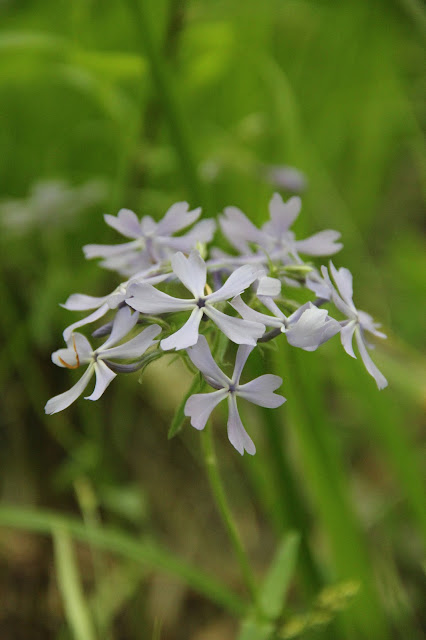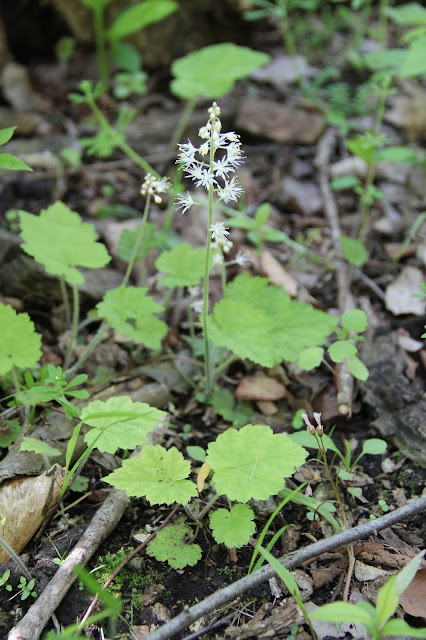Wildflowers of 2016 - #56 Canada Mayflower (Maianthemum canadense)
My first flower of the day was Canada Mayflower (Mainthemum canadense). Canada Mayflower is known by a variety of names. Its leaves bear a resemblance to Lily-of-the-valley so it is known as False Lily-of-the-valley and Wild Lily-of-the-valley. It is also known as False Solomon Seal - it shares the same genus (Maianthemum) with other False Solomon's Seal species.
The white flowers of Canada Mayflower bear a superficial resemblance to those of Baneberries (coming up at #58 and #67) or Foamflower (#65). Like those species, the white flowers of Canada Mayflower have long stamen, making each individual flower look like a 1950's Atomic Age art object.
 |
| Canada Mayflower - not a good picture, but the best one of the day |
This species can be found north of a line running from Georgia northwest to Wyoming and Montana and on to British Columbia and Yukon Territory. It is most common in the the States from New England westward to Minnesota. In Michigan, it has been documented in all but two of the state's eighty-three counties
Wildflowers of 2016 - #57 American Dog Violet (Viola labradorica)
American Dog Violet (Viola labradorica) has been renamed in recent years, it was formerly known as Viola conspersa, but has been lumped with V. labradorica - many books and websites still refer to it by its old name. American Dog Violet is one of several species of violets that have flowers stalks with leaves on them - many other species such as Common Blue Violet (V. sororia) have basal leaves and separate flower stalks.
 |
| American Dog Violet |
This species prefers wetter soils and is often found in floodplains forests, swamps, and other damp habitats. However it will also grow in drier habitats. It has been documented in all but even counties in Michigan. It can be found east of a line running from Florida northwest to Canada's Northwest Territories. There is a disjunct population that exists throughout much of Colorodo.
 |
| A colony of American Dog Violet in the cedar swamp at Mission Creek Park |
Wildflowers of 2016 - #58 Red Baneberry (Actaea rubra)
Red Baneberry (Actaea rubra) is one of two species of Baneberry found in Mid-Michigan. It can be distinguished from White Baneberry (A. pachypoda) by the color of its berries (red vs. white), shape of the flowers (less cylindrical than those of White Baneberry), hairs on the underside of its leaves (White Baneberry is hairless), and to a lesser degree by habitat (A. rubra is more likely to be found in wet soils than A. pachypoda). The best way to determine between the two species is by the berries. I am assuming this plant to be Red Baneberry based on all the above factors and the fact that I have identified this colony of plants to be Red Baneberry in previous years.
 |
| Red Baneberry |
This species has a wide distribution across North America. It has been identified in all states north of a line running from California/Arizona/New Mexico through Kansas/Iowa/Illinois to New Jersey. In several states it has bee documented in only a few counties.
Wildflowers of 2016 - #59 Cleavers (Galium aparine)
The next flower is known by several names Cleavers, Goosegrass, or Annual Bedstraw (Galium aparine). Cleavers is a native plant found around the world - Michigan Flora indicates that its range in Michigan is spreading northward. Cleavers is an annual plant that is normally found in upland sites, but may grow in wetlands - I found it growing through the Red Maple swamp at Mission Creek.
Cleavers is one of approximately twenty Galium species found in Michigan, most of which are similar in appearance. Like most of the other species, Cleavers has small white flowers with four petals. Cleavers can be identified by its leaves which grow in whorls of 6 to 8 (more than the other species).
 |
| Cleavers - note whorls of six to eight leaves and small white flowers |
Wildflowers of 2016 - #60 Downy Solomon's Seal (Polygonatum pubescens)
Species number five for the day and number sixty of the year was Downy Solomon's Seal (Polygonatum pubescens). The flowers of Downy Solomon Seal dangle beneath the plant's arching stem. The tubular pale green to white flowers grow from the leaf axils and are arranged either individually or in groups of two to three. Downy Solomon's Seal can be distinguished from the closely related Smooth Solomon's Seal (P. biflorum) by the small hairs which grow along the veins on the underside of the leaf.
 |
| Downy Solomon's Seal - note bell-shaped flowers dangling from leaf axils |
Wildflowers of 2016 - #61 Wild Blue Phlox (Phlox divaricata)
One flower that I look forward to seeing every year is Wild Blue Phlox (Phlox divaricata). This species is not common in Mt. Pleasant. In fact I only find it growing along the edge of the Red Maple swamp at Mission Creek Park and never in large numbers. On this occasion, I found a single plant.
 |
| Wild Blue Phlox growig along the edge of a swamp at Mission Creek park |
People often confuse Wild Blue Phlox with another flower - Dame's Rocket (Hesperis matronalis). The two plants are easy to distinguish if you look at the flowers. Dame's Rocket, a non-native member of the Mustard family, has flowers with four petals. Wild Blue Phlox has flowers with five petals. Unfortunately, Dame's Rocket is much more common in Mt. Pleasant.
 |
| Wild Blue Phlox - note 5 petals on each flower |
Wildflowers of 2016 - #62 Mayapple (Podophyllum peltatum)
 |
| A colony of Mayapple plants |
My next species of the day was the Mayapple (Podophyllum peltatum). The flowers of this species are hidden below a pair of large umbrella-like leaves. It often forms large colonies in wet woodlands.
 |
| Mayapple leaved hide the flowers below |
 |
| Mayapple flower |
For more information on this species, please see this profile from May 2013.
Wildflowers of 2016 - #63 Common Mouse-eared Chickweed (Cerastium fontanum)
The next flower is a non-native plant found in fields, lawns, roadsides, and other weedy places. Common Mouse-ear Chickweed (Cerastium fontanum) is originally from Europe but has been introduced in all fifty states and most of Canada (no records from Nunavut). Because the flowers of Mouse-ear Chickweed are tiny (less than 1/4 inch across) and the plant grows low to the ground, it is easy to overlook this species. This year I have been finding it in more widespread locations throughout the park system
 |
| Common Mouse-eared Chickweed |
 |
| Common Mouse-eared Chickweed - note five deeply-divided petals (looks like 10 petals) |
Wildflowers of 2016 - #64 Pennsylvania Bitter Cress (Cardamine pensylvanica)
Pennsylvania Bittercress (Cardamine pensylvanica) is the fourth Cardamine species on the 2016 list - the others were #14 Spring Cress (C. bulbosa), #20 Cut-leaved Toothwort (C. concatenata), and #33 Broad-leaved Toothwort (C. diphylla). Pennsylvania Bittercress is best identified by its leaves. It has compound leaves, but the separate leaflets often grow together along the stem (especially the three leaflets closest to the end of the leaf). Like the other three Cardamine species on this list, Pennsylvania Bittercress has small white flowers with four petals. The flowers of Pennsylvania Bitter Cress measure only about 1/8 inch.
 |
| Pennsylvania Bitter Cress - note small four-petaled flowers and compound leaves |
This species has been documented in forty-eight states of fifty states (Arizona and Hawaii excepted) and every Canadian province and Territory with the exception of Nunavut)
Wildflowers of 2016 - #65 Foamflower (Tiarella cordifolia)
Some of the flowers on my list have very specific growing conditions. This means that there are some flowers that I can only find in a few locations in Mt. Pleasant - sometimes only a single location. My tenth flower of the day was one that I went to Mission Creek specifically to find. Foamflower (Tiarella cordifolia) is often found in wet areas of deciduous and mixed forests. In 2014, I found this flower growing in two separate locations in upraised areas within the Red Maple swamp at Mission Creek. This year, I was only able to find it growing in one location, but I was searching nearly a week earlier so more flowers may still be coming.
 |
| Foamflower - note pair of basal leaves and elongated flower cluster |
Foamflower is also known as False Mitrewort because its leaves resemble those of Two-leaf Mitrewort. While the flowers of Two-leaf Mitrewort are arranged singly along a raceme, the blooms of Foamflower are arranged in a cylindrical cluster that rises up from the plants basal leaves. It is named Foamflower because the flowers long bear long stamen that give the flower a feathery or frothy appearance.
 |
| Foamflower - note long stamens that give the flowers a "foamy" appearance |
At this point I left the low area of Mission Creek and ascended in the upland portion of the park.
Wildflowers of 2016 - #66 Creeping Charlie (Glechoma hederacea)
It amazes me that I did not record Creeping Charlie (Glechoma hederacea) on my Wildflowers of 2014 list. Also known as Ground-ivy or Gill-over-the-ground, this European native has naturalized in forty-six states and across the southern tier of Canadian provinces and territories.
 |
| Creeping Charlie forms dense colonies in disturbed areas such as lawns |
This species prefers disturbed ground. Once established, it forms a dense carpet that crowds out less aggressive native species. Plants grow up to 1 foot tall, but are often much shorter. Flowers on this species are violet-blue to purple in color and tube-shaped. The species spreads by means of roots. I found a large colony growing along the side of the park's sledding hill.
Wildflowers of 2016 - #67 White Baneberry (Actaea pachypoda)
White Baneberry (Actaea pachypoda) is one of two Actaea specie to appear on this list - Red Baneberry appeared above at #58. I have already detailed how to distinguish between the two species. Like the above species, I am largely basing my identification of this plant on a previous identification of plants in this location.
 |
| White Baneberry - flowers will be replaced by white berries with black dots (doll's eyes) |
Wildflowers of 2016 - #68 Wood Anemone (Anemone quinquefolia)
Somehow, I almost missed the bloom of Wood Anemone (Anemone quinquefolia). In fact, I only found one flower and this was missing one of its five petals.
 |
| Wood Anemone - a solitary bloom |
The quinquefolia part of the scientific name refers to its five-lobed leaves.
 |
| Wood Anemone - note leaves with five lobes |
Wildflowers of 2016 - #69 Small Pussytoes (Antennaria howellii)
 |
| Small Pussytoes prefers dry soil and sunlight |
 |
| Small Pussytoes - note basal leaves |
My final flower of the day was found growing in dry soil at the southern edge of Mission Creek Park. Small Pussytoes (Antennaria howellii) grows from 4 to 16 inches tall and can easily be overlooked. Its clusters of small furry white or pink flowers resemble little cat's paws - giving the species its name. It can be found across the northern half of the United States and southern Canada. In Michigan it has been recorded in all but six counties.
 |
| Small Pussytoes - note furry flower clusters |
No comments:
Post a Comment